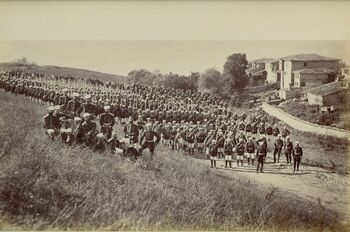Battle of Salinae
This article is incomplete because it is pending further input from participants, or it is a work-in-progress by one author. Please comment on this article's talk page to share your input, comments and questions. Note: To contribute to this article, you may need to seek help from the author(s) of this page. |
| Battle of Salinae | |||||||
|---|---|---|---|---|---|---|---|
| Part of 2nd Slavo-Roman War | |||||||
 Slavic Troops on the March to Salinae | |||||||
| |||||||
| Belligerents | |||||||
|
|
| ||||||
| Commanders and leaders | |||||||
|
|
| ||||||
| Units involved | |||||||
|
• 14th Cossack Regiment |
• Corpus Limetanei XXVI • Equites VI Sarmatia | ||||||
| Strength | |||||||
|
54th Rifle Division 12,400 men 150 guns 14th Cossack Regiment 2,100 men |
Legio XVII 24,500 men 120 guns Corpus Limetanei XXVI 2,400 men Equites VI Sarmatia | ||||||
| Casualties and losses | |||||||
|
3,400 1,250 dead |
14,450 9,560 dead | ||||||
The Battle of Salinae was a major battle during the 2nd Slavo-Roman War (War of Arckyskian Liberation), which saw the near total destruction of a Roman Legion, namely Legio XVII by vastly superior Slavic breech-loading artillery. The battle was also the origin of one of the most famous charges in modern history, Marcus' Charge; when General Marcus personally led his men on a charge against fortified positions of the 52nd Rifle Division in an attempt to topple them and save the bombarded legion columns by destroying the Slavic artillery. While the charge ultimately failed, seriously wounding Marcus in the process, the pressure caused the Slavs to switch their artillery fire and ultimately saved the remainder of the 2nd and 3rd Legionary columns.
Background
By early April of 1857, Slavic forces had finally broken the Siege of Lindum Colonia and had well and truly entered Roman territory. However, the troops were very stretched out following the rapid advance of the Central Army. One of the furthest forward deployed units was the 54th Rifle Division, which was screening the core of the army. Despite repeated requests to stop and regroup sent by the Divsion's commander, General of the Infantry Valentin Dubovic, the High Command ordered the division to push forward and threaten the vital economic areas of the empire.
During the siege of Lindium Colonia, Flavius Stilcho, managed to raise several legions from the Roman heartland itself. By the time the Slavic forces finally advanced into the Roman core territories, Legio XVII, XVIII and XIX were ready and deployed. The commander of Legio XVII got word of the precarious position of the 54th Division, and decided to set up an ambush near the town of Salinae. However, as the Roman Legion was preparing its position, it was spotted by the reconnaissance Cossack patrol, who after a brief skirmish, managed to outrun the slower Roman cavalry and inform the Commander of the division. Upon these news, General Dubovic immediately ordered his division to dig in, and dispatched couriers asking for assistance. General Marcus upon being informed of this, ordered his army to make camp, and began preparations to attack at dawn.
At sunset, Marcus Commidus received reinforcements: in both the requested cavalry, Equites VI Sarmatia, as well as a badly beaten Limetanei corp, the commander of which never the less accepted Marcus' command. However, Marcus himself had little trust in the Limetanei and thus relegated them to guard the camp.
Order of Battle
By early morning Slavs had taken their prepared positions on a slight hilltop, digging several lines of trenches and hastily erecting artillery encampments. General Dubovic sent out several Cossack patrols to skirmish with the enemy and to report when the main attack had started. Also the night before, the General ordered artillery practice drills against a narrow river at the base of the hill; correctly guessing the main Roman attack would come from there. At night, sappers filled the craters left behind by the shells to attempt to conceal the bombardment.
At dawn, General Marcus ordered the legion to prepare for battle, giving a short speech to his men before ordering them into three columns. Columns 2 and 3 under the command of their respective lieutenants would march through the forest, across the river and up the hill, to overrun the Slavic positions, while the General, the Equites and the 1st column would march along the highway, and flank the Slavs from the side of the hill.